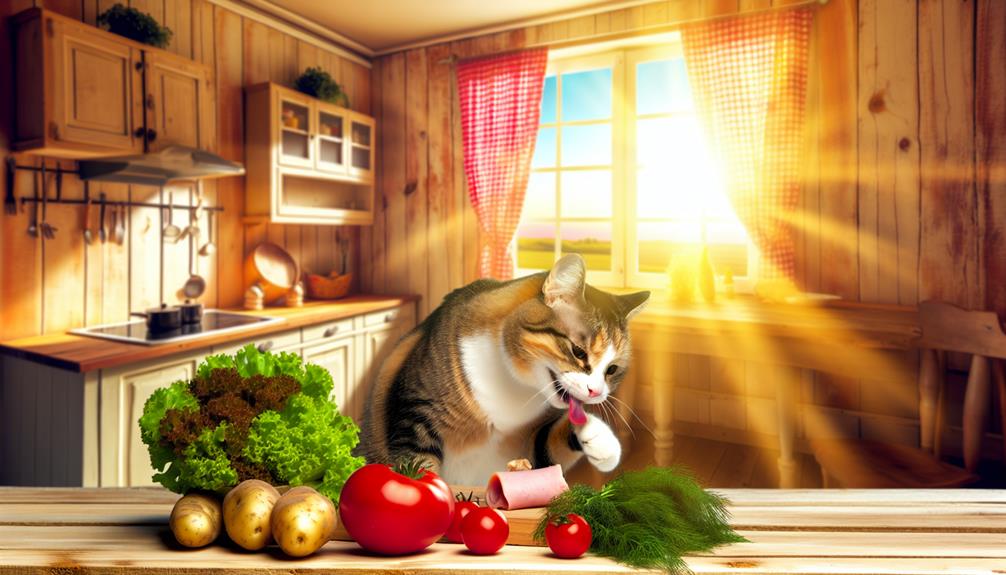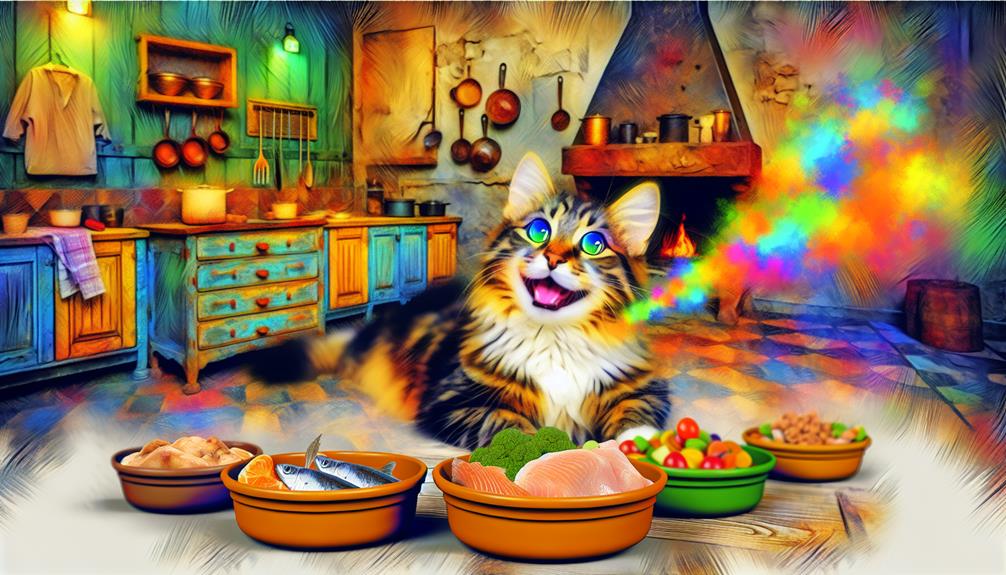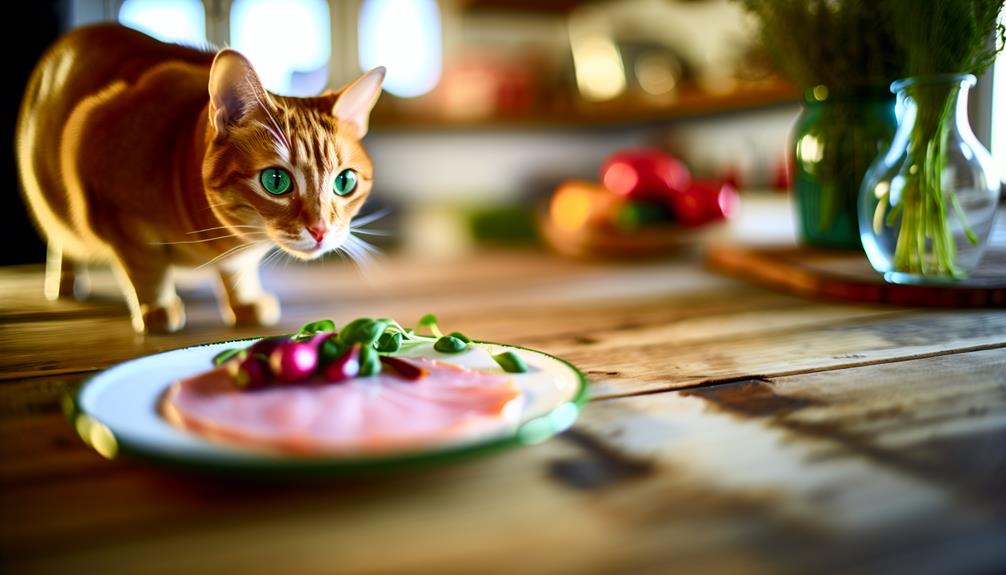When you're contemplating whether cats can eat ham, it's crucial to weigh both the benefits and the risks. Sure, ham is high in protein, which might appeal to your feline friend, but it's also loaded with sodium and fat. You wouldn't want to compromise your cat's health with something that seems like a tasty treat. So, how can you make certain you're offering it safely, and are there better alternatives to ponder? Let's explore this further to guarantee your cat stays happy and healthy.
Nutritional Content of Ham
When considering whether cats can eat ham, it's important to first understand the nutritional content of this meat. Ham, a type of processed pork, has a specific nutritional profile that includes various components vital for evaluating its suitability for feline consumption. Primarily, ham is known for its high protein content, which is essential for a cat's diet since cats are obligate carnivores and require a protein-rich diet to thrive.
In a 100-gram serving of ham, you can find approximately 18-20 grams of protein. This level of protein is beneficial because it supports muscle maintenance and overall health in cats. However, it's also important to note that ham contains added ingredients not typically found in other meats, such as preservatives, flavorings, and high levels of sodium. These additives can alter the overall ham nutritional profile, making it less ideal for cats compared to unprocessed meat sources.
Furthermore, the fat content in ham is relatively high, with about 8-10 grams of fat per 100 grams. While cats do require fats for energy and skin health, excessive fat intake can lead to obesity and related health issues. Additionally, ham provides some vitamins and minerals, including B vitamins, iron, and zinc, which are beneficial but can be obtained from other, more suitable food sources.
Risks of Feeding Ham
Despite ham's appealing protein content, there are significant risks associated with feeding it to cats. One of the primary concerns is the high sodium content in ham. Cats have a much lower tolerance for sodium than humans do. Excessive sodium intake can lead to sodium ion poisoning, which manifests as vomiting, diarrhea, lethargy, and in severe cases, seizures or even death. The sodium concerns are particularly pressing because commercial ham often contains preservatives and additives that further elevate its salt levels.
Another potential health issue is the presence of nitrates and nitrites, common preservatives in processed meats like ham. These compounds can be toxic to cats, affecting their red blood cells' ability to carry oxygen and potentially leading to methemoglobinemia, a serious condition that can cause respiratory distress.
Moreover, ham's high fat content can contribute to pancreatitis, a painful and potentially life-threatening inflammation of the pancreas. Cats' digestive systems aren't designed to handle large amounts of fat, and chronic consumption can lead to obesity and its associated complications like diabetes and arthritis.
The texture and seasoning of ham also pose risks. Many hams are flavored with ingredients like garlic and onions, both of which are toxic to cats and can cause gastrointestinal upset or more severe conditions like hemolytic anemia.
Lastly, bones in ham can be hazardous. Cooked bones are brittle and can splinter, causing choking or puncturing your cat's digestive tract. Given these potential health issues, it's essential to consult your veterinarian before introducing any new food into your cat's diet, including ham.
Benefits of Ham for Cats

While it's vital to be aware of the risks, under certain conditions, ham can offer some benefits for cats. One of the primary ham benefits is its role as a protein source. Cats are obligate carnivores, meaning they require a diet rich in animal proteins to thrive. Ham, when served appropriately, can supplement their protein intake. Protein is important for maintaining muscle mass, tissue repair, and overall cellular function in felines.
Another advantage of ham is its potential for flavor enhancement. Cats can be finicky eaters, and introducing a small amount of ham into their diet might stimulate their appetite, especially if they're recovering from an illness or are generally picky. The distinct flavor of ham can make their regular food more enticing, ensuring they receive the necessary nutrition.
Ham can also serve as an occasional treat. Treats are useful for reinforcing positive behavior, particularly during training or when trying to acclimate your cat to new environments or routines. Offering a tiny portion of ham occasionally can be a rewarding experience for your cat, creating positive associations without disrupting their overall dietary balance.
However, it's important to remember that ham should not replace a balanced feline diet. It should be provided sparingly and under conditions where its benefits can be maximized without introducing health risks. Ensuring your cat gets a well-rounded diet with all essential nutrients is paramount. Thus, while ham can offer unique benefits like being a supplementary protein source, enhancing flavor, and serving as an occasional treat, it should always be given with caution and awareness of potential risks.
Safe Serving Suggestions
To safely incorporate ham into your cat's diet, it is crucial to adhere to specific serving guidelines. First and foremost, the ham should be plain and free of any seasonings, preservatives, or additives that could harm your cat. Cats are obligate carnivores, meaning their dietary needs are quite specific, and even small amounts of harmful substances can cause issues.
When considering cat preferences, remember that moderation is key. Ham should only be an occasional treat, not a staple in their diet. A small, bite-sized portion is sufficient. Typically, portion sizes should be no larger than a couple of small cubes, roughly the size of a pea. This guarantees you're not overloading your cat with salt and fat, which are prevalent in ham and can lead to health problems like obesity or hypertension.
Furthermore, always verify the ham is cooked thoroughly. Raw or undercooked ham can pose a risk of bacterial contamination, such as Salmonella or Listeria, which can be detrimental to your cat's health. Avoid deli or processed ham, as these often contain added sugars and nitrates that aren't suitable for cats.
It's also advisable to observe your cat closely after introducing ham. Some cats might have sensitivities or allergies to pork products, which could manifest as gastrointestinal upset or skin issues. If you notice any adverse reactions, discontinue feeding ham immediately and consult your veterinarian.
Alternatives to Ham

Although ham can be an occasional treat, it's important to explore other protein options better suited for your cat's nutritional needs. Cats are obligate carnivores, meaning their diet should primarily consist of meat. While ham is high in sodium and preservatives, other protein sources can provide a healthier and more balanced diet.
Consider chicken treats as a primary alternative. Chicken is a lean protein that's low in fat and easy to digest, making it an ideal option for cats. You can offer your cat cooked, unseasoned chicken breast as a treat or incorporate it into their regular meals.
Fish options are another excellent alternative. Fish like salmon, sardines, and mackerel are rich in omega-3 fatty acids, which support skin and coat health. However, fish should be given in moderation due to potential mercury and toxin exposure. Always verify the fish is cooked and free from bones.
Here's a quick comparison of protein alternatives:
| Protein Source | Benefits | Considerations |
|---|---|---|
| Chicken Treats | Lean, easy to digest | Avoid seasoning |
| Salmon | Omega-3 fatty acids | Risk of mercury exposure |
| Sardines | Rich in nutrients | Should be given in moderation |
| Mackerel | Supports coat health | Verify it's cooked |
In addition to chicken and fish, other meats like turkey and beef can also be included in your cat's diet, provided they are prepared properly—unseasoned and cooked to avoid any bacterial contamination. By diversifying protein sources, you'll meet your cat's nutritional needs more effectively while minimizing health risks associated with processed meats like ham.
Conclusion
To sum up, while ham can be a tantalizing treat for your feline friend, it's best to tread lightly. The high sodium and fat content, along with potential additives, mean it's not the healthiest choice. Offering plain, cooked ham in moderation can be acceptable, but always prioritize a balanced diet with fresh, whole foods. Keep an eye on your cat for any adverse reactions and consult your vet if you have concerns. Remember, a little indulgence goes a long way.
